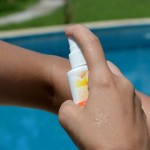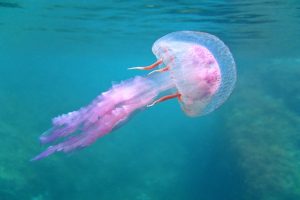Are you treating jellyfish stings with the right liquid?
An estimated 150 million people are stung by jellyfish globally each year. In most cases, the sting is painful, but not life-threatening and easily treatable.
For a rare few, a sting can lead to vomiting, trouble walking, nausea, headaches, and seizures. The most dangerous sting—from the box jellyfish found in Australia and the South Pacific—can cause anaphylaxis, a severe allergic reaction that can lead to death. Symptoms include trouble breathing and swallowing, along with hives.
How to know if you’ve been stung by a jellyfish
A jellyfish sting will lead to painful, irritated marks on the skin. These red, brown or purplish tracks are the imprint of where tentacles made contact with skin. Hives or blisters may occur in the sting area.
Victims of a jellyfish sting commonly describe burning, prickling or stinging sensations.
“For the vast majority of cases, the pain begins within minutes, peaks approximately five minutes after the sting and lessens in a few hours,” says Robert Greer V, DO, a third-generation osteopathic physician with a family practice in West Palm Beach, Florida. “While the pain will vary greatly in severity, it generally won’t last longer than 24 hours.”
Itching can linger for a week and marks on the skin may last for weeks.
What is the best treatment?
Advice varies slightly by region, but physicians broadly agree upon the following three treatment steps.
First, remove any tentacles or stingers that remain on the skin with a pair of tweezers or gloved hands. Do not touch the stingers with bare hands. In a pinch, a credit card or other utensil can be used, but be careful not to spread the venom onto untouched skin.
The second step is to rinse the area with a topical treatment like Sting No More or vinegar, commonly available at lifeguard stations. Finally, apply a heat pack or immerse the affected area in hot water for 20-40 minutes.
The use of a mild hydrocortisone cream or an oral antihistamine may help relieve itching and swelling.
Seek medical attention for worsening symptoms or if you experience swelling or a throbbing pain that radiates up a leg or an arm. Stings to the eyes or mouth should be treated by a physician.
What not to do
While it may be tempting to immediately rinse the affected water, do not pour cold drinking water on the sting because it can release more venom and increase your pain. In the absence of vinegar or sting spray, wash with saltwater.
Urinating on the sting will not help.
“Pure fiction,” says Dr. Greer. “We don’t know how the pee myth evolved but it’s not a good practice.”
Do not use bare hands to wipe the area because the venom may still be active.
How to prevent jellyfish stings
Talk to lifeguards, local residents or officials with a local health department before swimming or diving in coastal waters, especially in areas where jellyfish are common. Stay out of the water when jellyfish numbers are known to be high.
When swimming in areas where jellyfish are present, wear a wet suit or other protective clothing. Diving stores sell protective “stinger suits” made of thin, high-tech fabric. Protective footwear is encouraged in shallow water.
Why do jellyfish sting people?
Because jellyfish are slow, weak animals, they use their tentacles to sting and immobilize their prey by discharging a tiny, harpoon-like structure that carries venom. Jellyfish do not seek humans so stings usually result from accidental contact, notes Dr. Greer.
Tentacles that have detached from the jellyfish can continue to sting. Avoid touching jellyfish at all times, even if they have washed up on the beach.

